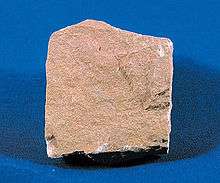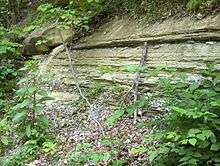Siltstone
Siltstone is a sedimentary rock that has a grain size in the silt range, finer than sandstone and coarser than claystones. It is differentiated from shale by having majority silt, not clay.[1]
| Sedimentary rock | |
 Siltstone |
Description
Siltstone is a clastic sedimentary rock. As its name implies, it is primarily composed (greater than 2/3) of silt sized particles, defined as grains 2–62 μm or 4 to 8 on the Krumbein phi (φ) scale. Siltstones differ significantly from sandstones due to their smaller pores and a higher propensity for containing a significant clay fraction. Although often mistaken for a shale, siltstone lacks the laminations and fissility along horizontal lines which are typical of shale.[1] Siltstones may contain concretions. Unless the siltstone is fairly shaly, stratification is likely to be obscure and it tends to weather at oblique angles unrelated to bedding. Mudstone or shale both contain mud, a material composed of a range of silt and clay.

See also
- Cosmetic palette – made almost exclusively out of siltstone with a few exceptions
Footnotes
- Blatt et al. 1980, pp.381-382
References
| Wikimedia Commons has media related to Siltstone. |
- Folk, R.L., 1965, Petrology of sedimentary rocks PDF version. Austin: Hemphill's Bookstore. 2nd ed. 1981, ISBN 0-914696-14-9
- Blatt, Harvey; Middleton, Gerard; Murray, Raymond (1980). Origin of sedimentary rocks (2d ed.). Prentice-Hall. ISBN 0136427103.
- Williams, Howel, Francis J. Turner and Charles M. Gilbert, 1954, Petrography, W. H. Freeman